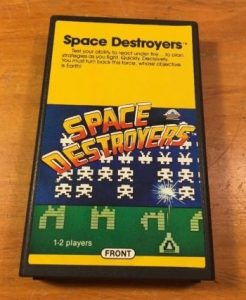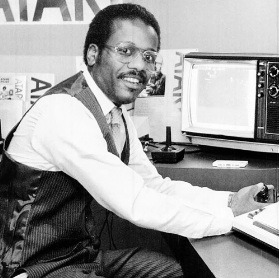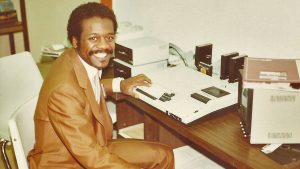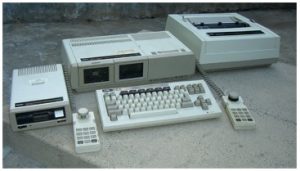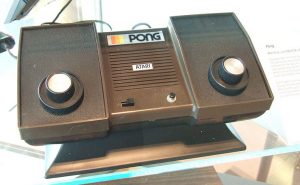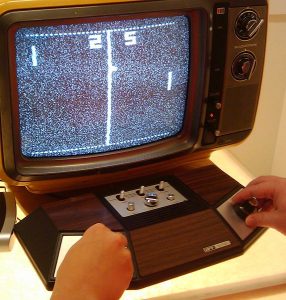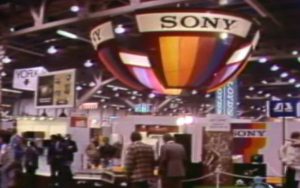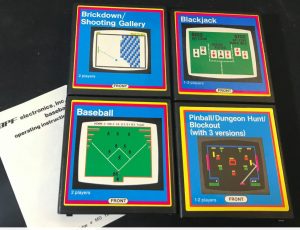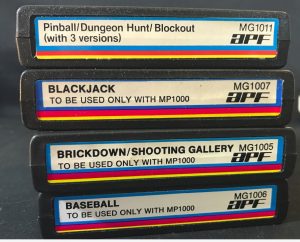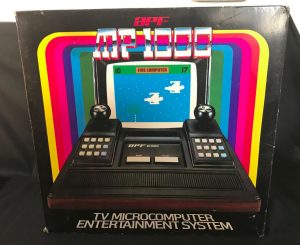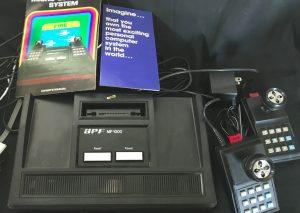INTERVIEW: Ed Smith on game development in the bronze age of digital entertainment – the 1970s (English)
The 1980s was the decade of video games and home computers. Next to the well-known industry-leaders such as Coleco, Intellivision or Atari, the American company APF also tried to get its share from the rapidly growing home screen entertainment market in the 1970s. Their game and computer development was largely developed by Ed Smith, a young engineer who had a great passion for math and computer sciences and of course video games. However, one aspect made him appear slightly different from other game industry employees … his skin color. Ed Smith is one of only two black game hardware developers of the 1970s known today.
Ed, can you quickly point out what you did at APF and what brought you to this position?
At APF, I was one of 3 engineers who developed the MP 1000 video game and later The Imagination Machine. My role was to assist in the design of the IO (cartridge slot and expansion bus) and video output. I was also responsible for building and testing the prototypes and video games as well as drafting the schematic diagrams. I arrived at APF after leaving Marbelite where I was trained on microprocessor controlled traffic systems. I wanted to move out of the Brooklyn factory rut and into mainstream NY employment. I went to one firm to help design computerized point of sales systems, but was not really thrilled about this technology. I went back to my employment agent and got the interview at APF.
The 1970s must have been a remarkable decade. Man landed on the moon, the war in Vietnam was over, computer technology seemed to be able to help building a better future. How did it feel to work with such a technology, in this time and era? Did you feel special in any way – as an individual working in this field, with this technology? „Chosen“ maybe? Or was it a job like many others?
The 70s was also a period of unrest in the urban areas. To be able to study technical electronics seemed to be a natural progression of my life but not an easy one. I love to figure out how things are made. It’s that simple. And when you have a curiosity like this you tend to migrate to people and places where there are like minds. That’s why I went to Westinghouse High School and read magazines like Popular Mechanics and Omni Magazine. Frankly, I never felt special about working in this field but I did feel the need to show people I knew this as well as anyone. I had the best of both worlds – being able to provide for my family while doing something I truly loved. Chosen? No, more like Compelled.
In his book „Computer Power and Human Reason“ (1976 – a masterpiece) Joseph Weizenbaum described the working habits and environments of early game programmers and developers in a way that we would call „nerdy“ today – spending days and nights at the office, smelling strangely and trying to „break the will“ of the computer as if it was a stubborn individual. Was it really like this?
I will indeed read the book since that’s exactly what it was like. Our work environment was loose and geeky. If we wanted the marketing guys to stop asking questions we would start talking about Ram, Rom, shift registers and such. When we got stuck with something we would go have a liquid lunch. When we think we were getting close to an answer (breaking that CPU’s will) we might be there doing peeks and pokes long until after the Chinese take-out or pizza was gone. There were at least 3 all-nighters I can remember when we had to meet deadlines. Smelled pretty bad and took the train home the next day. Funny, I had more space around me than normal.
The upper management at APF followed a traditional 9 to 5 time schedule while the generation of game developers had a rather „laid back“ style. This sounds funny at first, but can quickly go on one’s nerves. Was this a source of constant conflicts or did the management later accept the different habits of the creative force?
We did indeed have a more flexible work schedule but back then – even the sales guys worked late. I can recall sitting in one of the Lipper’s office (bosses of APF) after hours just hashing things out around who would buy the systems and how we should show them. From day to day we would either work 3 hours or 30. We didn’t care. We were having fun. Never an issue with upper management.
In an earlier conversation you said that you tested the game „Space Destroyer“ for hours and hours… This reminded me of testing the much more complex productions of the 1990s when I was working in that industry before we were able to create any master-disks or later CD-Roms and I wondered… what was testing a game like in the 1970s? An eepromed cart hooked up to a console? Did you have a testing plan? Or were the games too limited? Then again, games like your „Baseball“ could come up with some odd miscalculations I guess.
Although we had a Motorola ROM development and code test system, this statement will tell you how raw we were. We put so much energy into the console and games we didn’t develop a test environment…. so… in steps Ed to play every game to the highest level.
What kind of typical errors popped up? Crashes of any sorts? How was the testing procedure organized? How long did it take in general?
ROM testing was quick and would catch code errors. The most common production error was freezing. Had to poke registers to find where the error was. This process would take a day or two to resolve. That’s due to other development activities.
Today, having the Internet and therefore access to all sorts of information, it appears to be easy to quickly evaluate new ideas or to do research on a new topic. How would you describe the situation in the 1970s?
Folks have it easy today. Our research in the 70s was spending hours in the library, reading magazines or at workshops. We had to get up and go find what we needed to know. The network of engineering folks was extremely important. I kept up with the engineers from my old firm Marbelite and had the phone numbers of top engineers at Fairchild, Motorola and even Apple.
Was there any exchange with other game developers or rather leisure hardware engineers? And since APF was located on the east coast while a lot of the gaming fuzz was happening on the west coast, did you feel a bit displaced back then?
The disconnect with the west coast was a big problem for us. Not many engineering types were living in New York at that time. In hindsight I probably should have gone west. Good thing is we had consumer electronics shows at the Javits Center, McCormick’s Place in Chicago and Moscone Center in San Francisco. These events allowed me to maintain a connection with the west coast.
When I read Steve Job’s biography I had the impression that the secret hub for creative talents in the 1970s was Radio Shack stores. Would you agree on this? Was this the place where the interesting people met and where they shared their fascinating ideas?
The Shack was absolutely tech heaven! We could buy resistors, capacitors, power amps and more. The sales guys knew their stuff so it was like walking into the “Church of Tech”. Folks would come in and talk about what they are working on and before you know it you are there for hours.
- Ed Smith, Winter CES 1981 mit dem IM2 Computer-Prototypen (Bild: Ed Smith / Benj Edwards)
- Coleco Adam Heimcomputer (Bild: Piasecki: Credere et Ludere, S. 110)
APF’s marketing dept. spoiled to some degree the possible success of the engineering dept. when in 1979 it was opting for a cassette drive instead of a disk drive for the Imagination Machine. This strongly reminds me of the fate of Atari, where the management or marketing forces often spoiled interesting designs or great developments. Why is it, in your opinion, that over the years marketing did not learn to listen to the specialists?
You have a dilemma with two groups that are at opposite ends of the bell curve. I always said that to build great technology get the marketing folks out of the way. I doubt that Steve Jobs had anyone in the room from marketing while designing the Mac or iPhone. Marketing’s role is to tout capabilities simplistically.
The earlier APF products were attempts to benefit from the success of the early original Pong games by Atari. The game system that you worked on, the APF MP1000 was an interesting piece of hardware. Was it produced to be just another game system on the market or did the company have a different attitude – to avoid having to put an entirely new pong-style console on the market for every new game variation? Did you, the developers, try to achieve something special? What I mean is – did a developer back in the day follow any special spirit?
I will be perfectly honest with you and say our entire company was in the business of delivering low cost knock-offs. Our intention was to follow Atari as the Avis of video games. Our focus was to look at what Atari and others did and go after it with low cost alternatives. This was our business when we sold low cost adding machines and calculators, leveraging our connection in China. There was never any theme or desire to build a game changer – only an extreme interest in breaking down theirs and then building our technologies. Totally geeky.
Can you recall customer reactions on the machine? Did they compare it to the Atari 2600? I like what you once mentioned about the kids in your neighborhood when you donated a pile of consoles to them. First they didn’t know what it was but then they intuitively got it. I wonder if kids today would be able to understand what it is about (there are some interesting videos on YouTube showing modern kids trying to use older tech).
Customers were very enthused about the Imagination Machine. We had lines of folks looking at it at CES in 1979 (SP: see these awesome pictures from various CES’s spanning several decades from 1967-2014), asking questions about our Basic interpreter. Everyone was comparing it to the 2600 – users, writers, etc. Same for the Adam from Coleco. The thing I love about technology is the way you are able to engage with it. What I mean is no matter what the technology, you must learn the User Interface. Some are easy to grasp especially with the technology of today. But think about those kids in my neighborhood who just grabbed that joystick and went nuts! So my point is if you are young and willing to put tech in your hand, you will grasp it – no matter how old it is. On the flip side, my mother can’t even use a “smart phone”.
One thing that caught my attention was your statement to Benj that the games console kept the kids inside the house, spending their time with games instead of playing on the streets. From an educational point of view many teachers wouldn ́t find this to be a good effect today. But in this environment they lived it probably was better than having them on the streets?
Playing on the MP1000 in someone’s apartment was indeed a way to be engaged and stay out of trouble. The problem with video games today is the violence. I wouldn’t want any child sitting around playing Grand Theft Auto. That said, the Wii was one of the first systems that makes up for this by playing interactively with motion. I have seen them in schools, nursing homes…
Combining a games console with computer peripherals was already done with the 2600 – a Basic-programming module existed as well as a keyboard. What it lacked was data storage capabilities. Coleco was next trying to achieve this with their Adam system. Did APF have these other companies in mind when it created the Imagination Machine around the M1000?
Yes. As I mentioned, we reverse engineered the Atari, Intellivision and the Coleco. We got some of the expansion technology ideas from those systems. To be honest, I was never a fan of building a PC around the MP 1000. I wanted to see us with a stand-alone unit with expansion slots like the Apple. As a PC enthusiast, I had a pretty good idea folks would migrate to this technology. We did finally build the IM 2 with the expansion bus but too late.
The game system was designed and developed in the US, does the same apply to the games?
All of the games were written by a female programmer here in the US. I don’t recall her name but she was very sharp and did this using machine language.
- APF MP1000-Spiele (Bild: Piasecki)
- APF MP1000-Spiele (Bild: Piasecki)
- APF MP1000-Konsole in der Verpackung (Bild: Piasecki)
You were one of the very few Afro-American people who worked in the industry at this time. When I was working in the game industry from 1993-2004, race or gender (or religion) never mattered to anybody I knew. This I personally think is something the game industry has in common with artists and art in general. In another interview Benj Edwards quotes Marty Lipper (financial director of APF back then) saying that race never played a part during the hiring process at APF. Did it later in your career – you have mentioned this sales person in that chain store who replied „oh, you really did“ when you told him that you designed the console? Or would you say that the games business is truly an open-minded sphere?
I would like to tell you your thinking is accurate but the reality was then and still is today that when I tell someone I helped to design video games and PCs I get the same response – a look of surprise and then almost passing me off as if I was lying. In the late 70s, I would only gain respect when I sat down at the keyboard and started banging out code. If they didn’t see me do it, they would never believe it. By the way, I would have to look hard to find anyone else of color at those electronics conferences. I recall moving to Raleigh, NC over 10 years ago and moving into a nice big home on a golf course. I told my wife Sheila to be ready for the questions from our neighbors who likely thought I was doing something illegal. When I told them my background, I could tell no one believed me. It wasn’t until I pulled out an issue of Black Enterprise where I was interviewed that they finally get it. I would like to mention formally that if not for the support of the Lipper family and my mentor Ken Boilen, this story would never have been told.
As you probably know, Europe and especially Germany is the goal of millions of people from Africa or the middle east at the moment. Do you think gaming is an activity that is good for bringing people together? Can the development of even simple games for a hobby be a good tool and a way to let people work on something together?
I am passionate about this. We are not leveraging technology as well as we can for the good of people everywhere. Video game interaction has no color, no language barrier, no judgement. Imagine a group of folks from different nationalities sitting in front of a video game that would help them to understand each other’s culture? The advent of AI makes this type of thing even more achievable.
Thank you very much for the exciting view into the early years of console-gaming.
(Interview conducted by Stefan Piasecki, acknowledgment goes to Benj Edwards for providing the contact)
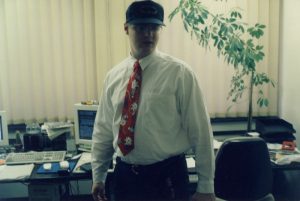
It is only fair to also share a pic of my younger years: Stefan 1994 at Blue Byte´s offices, wearing a fancy Battle Isle 2-cap – and a tie! (Bild: Piasecki)
START: „Video game interaction has no color, no language barrier, no judgement“ (English / German)
Video: Ed Smith on his 40+ years of engineering work for APF, Apple, Novell and others
More information on Ed Smith and his creations can be found here:



